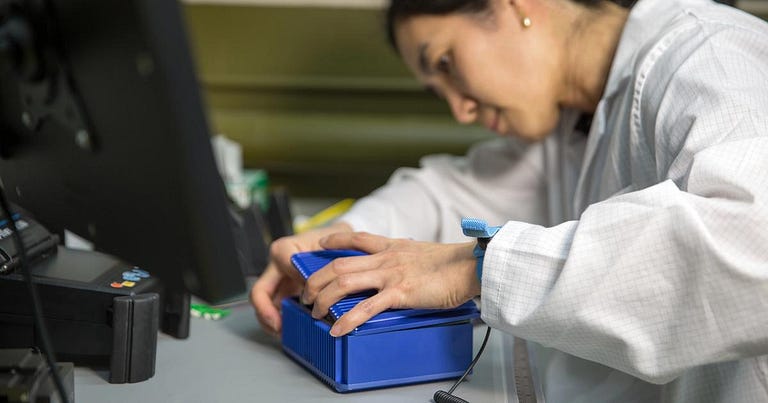Coherent Random-Modulated Continuous-Wave (RMCW)


FREQUENCY-MODULATED CONTINUOUS-WAVE (FMCW)

FMCW LiDAR http://www.mingwulab.berkeley.edu/research/fmcwlidar/


RMCW
by CIBBY PULIKKASERIL, FOUNDER & CTO, BARAJA:
Automotive LiDAR is quickly growing in importance for Advanced Driver Assistance Systems (ADAS) and automated driving systems (ADS), however, the sheer volume of technologies and terms used to describe LiDAR make it difficult to compare different sensors. At Baraja, we are the pioneers of Spectrum-Scan™ + RMCW LiDAR, which we believe is the holistic architecture that can meet the requirements of automotive LiDAR. Spectrum-Scan™ is well described in our white paper, but RMCW is a less common term. What is it?
What is RMCW?
Random modulated continuous wave (RMCW) LiDAR is a technique published in Applied Optics by Takeuchi et al. in 1983. The idea was to take a continuous wave laser, and modulate it with a pseudo-random binary sequence before shooting it out into the environment; the returned signal would be correlated against the known sequence and the delay would indicate the range to target. Creating RMCW signals is easy — our semiconductor laser was built for telecom, so it is naturally designed to be modulated with digital signals, and this method is robust to temperature, vibration, and aging effects.
Why it works
The benefits of this approach are well suited for LiDAR — the resulting correlation turns the pseudo-random signal, which to the human eye, looks just like noise, into a sharp pulse, providing excellent range resolution and precision. Thus, by using low-speed electronics, we can achieve the same pulse performance used by frequency-modulated continuous wave (FMCW) LiDARs that use much higher speed analog electronics. Even more interesting, we correlate the return signal against a known sequence, so any other signal — from the environment, another LiDAR, or another Baraja LiDAR — is correlated to zero. Thus, we have incredible immunity to interference, and this can be dialed in by software. The LiDAR system could actively change its RMCW modulation on-the-fly in response to signals coming in from the environment.
RMCW vs FMCW
RMCW LiDAR is often confused with FMCW LiDAR, perhaps unsurprisingly since they both have “continuous wave” in the description. Nevertheless, they are fundamentally different modulation techniques. FMCW LiDAR sensors will modulate the frequency of the laser light, a relatively complicated operation, and then attempt to recognize the modulation in the return signal from the environment. This involves two complexities in the architecture — it is extremely important to create a linear frequency modulation, and the quality of the laser, in terms of spectral purity, must be very high.
RMCW vs ToF
Both RMCW and FMCW LiDAR offer extremely high immunity from interfering lasers — compared to conventional ToF LiDARs, which are extremely vulnerable to interference. Interestingly, a group of Korean researchers (Hwang & Lee, 2020) built equivalent RMCW, FMCW and ToF LiDAR systems, and then created an aggressive interference scenario; the conclusion was that RMCW modulation was twice as robust to interference, which caused a degradation in SNR on return signals. This demonstrates the value of using pseudo-random codes, which are highly distinct from each other, as a modulation technique for next-generation LiDAR systems.
RMCW and Doppler
That’s not all! As we’ve demonstrated in May 2022, Spectrum-Scan™ + RMCW is also able to produce instantaneous velocity information per-pixel, also known as Doppler velocity. Having velocity in a point cloud enables machine learning techniques to make extremely informed classification decisions, as it becomes trivial to separate moving objects from stationary objects. This advanced feature is simply not possible with conventional LiDAR, and requires significantly augmented technology to extract the instantaneous velocity, which requires detecting a frequency shift that is roughly 1/10,000,000th of the carrier frequency.
Baraja’s Spectrum-Scan + RMCW LiDAR technology answers the two big problems in designing a LiDAR. One, how do you steer a laser beam A: with Spectrum-Scan, and two, how can you measure the distance to a target, A: with RMCW ranging. This provides a comprehensive solution to deliver an automotive LiDAR product for ADAS and autonomy, and the feedback we’ve heard from customers is “why has no one else come up with an elegant design like this?”.
Reference
- Originally published at https://www.baraja.com.